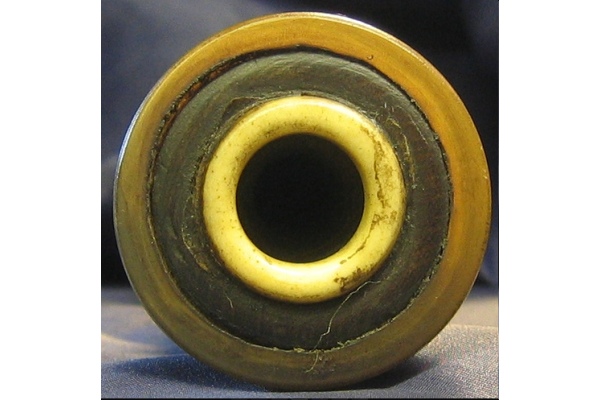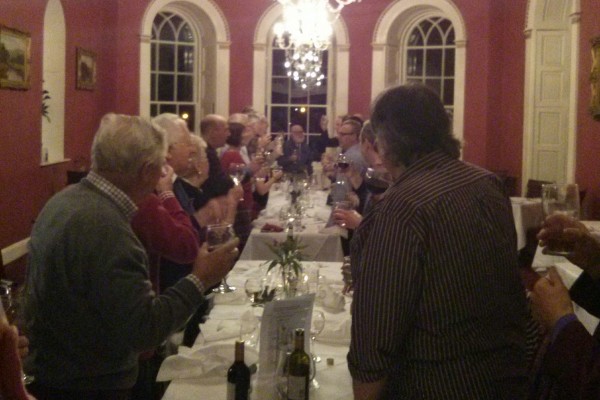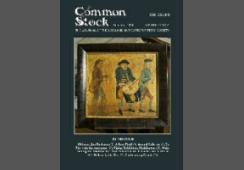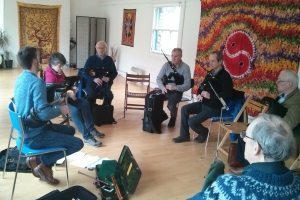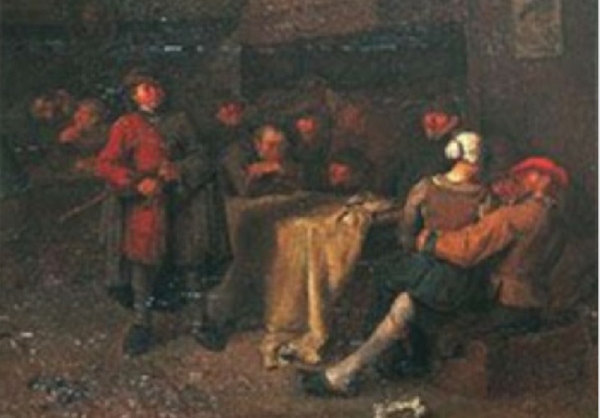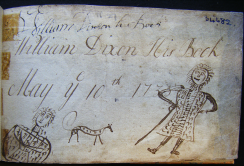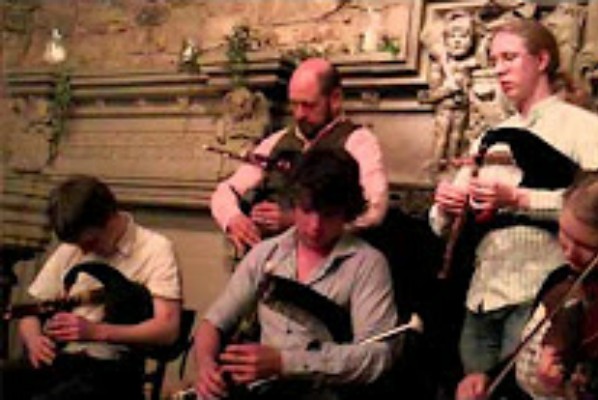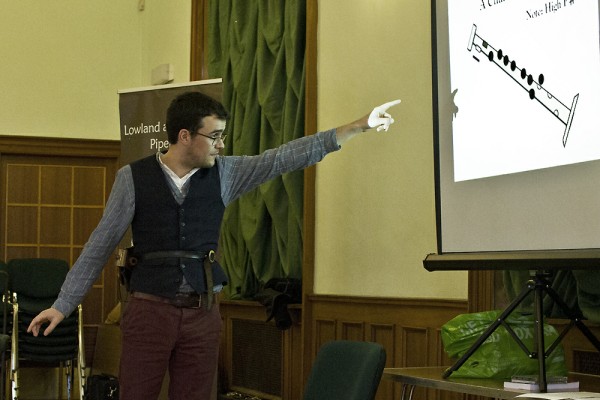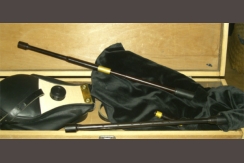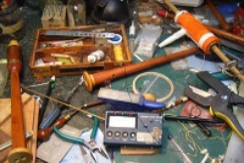A preliminary investigation of a neglected topic
The Dictionary of the Scots language has nearly fifty different spellings of the word ‘swesche’ from the 16th and 17th century. The origin of these words is a story of two centuries of almost continuous conflict in Europe that begins around the time of the battle of Sempach in 1386, when the first mention was made of the use of fifes and drums as signals by the Swiss in a military campaign.1
By the early 15th century, many elite Swiss fighting forces were employed throughout Western Europe as mercenaries, since each canton in the confederacy that made up ‘Switzerland’ at the time maintained its own armed band, which could be hired as a single unit for service beyond its canton.
These bands became much in demand, largely for the fighting techniques they developed using long pikes (18 feet!) in tight formation. These units required signalling systems to control their movements, and they proved so effective that their signals and marches using drums & fifes were quickly adopted for use in other European countries, including the Scots.

The Scottish mercenary had been a fixture in Europe since at least the 13th century. Perhaps at no other time was this Scottish presence more felt on the continent than in the early 17th century. Current estimates are that there were 38,550 soldiers raised over 27 levies from 1624-42 authorized by Charles I and Privy Council of Scotland for service in Danish and Swedish armies. Scottish soldiers and their Scottish officers were a major presence in the Danish and Swedish armies during the 30 Years War, but the mercenary bands that pre-date the regiments that Charles I authorized had been involved in wars with the Spanish and other nations from at least 1560.
That there had been influential contact between Swiss and Scottish mercenaries by the early years of the 16th century is revealed by the presence of words of the sort that appeared in the records of the Edinburgh Guild of Hammermen in 1524: ‘To the boy that playt of schues’2
And such records went on appearing until the middle of the 17th century, in all their glorious inventiveness of spelling:3 a small selection gives a flavour of this, as well as revealing the kinds of use that the ‘swesche’ might be put:
‘To the man that playit on the new swas; 1529’
‘To ane to play throwch the toun of Leith upoun ane swesche, to wairne the hors tocum and ressave thair charges; 1547’ :
‘To ane boye to pas throuche the town with the swess to proclame the fast’
‘To Paull Fasyde swyssar to stryk the drum affoir the toun on the mustar day; 1574’
‘gevin to twa men to play on ane swas and ane trumpet to the men of weir; 1544’ Scotland, of course was not unique in this adoption of the drum for civic or recreational use; in the city of Basel the officers of the merchant guilds, in whose hands lay the defence of the city’s territory, acquired military experience in Swiss regiments abroad and brought back with them their drum and fife marches. The guilds were also the centre of the city's social life, so that the playing of drums and fifes lost its military significance and became a popular custom such that Erasmus of Rotterdam wrote to his friend Valerius in 1529;
"In Basel the drums are heard not only in war but at weddings and on holidays too, indeed even in the churches, and the children run in the streets and the young brides dance to their sound.”5
As for the drum itself, the first descriptions come in 1511 in Sebastion Virdung’s Musica getutscht, published in Basel. He shows two different sizes of drum, and says that the smaller instrument is played together with the one-hand flute (Schwegel) for dance and wedding, the larger one with the whistle of the "war knights", ie in the military arena. The image of the drum shows an instrument with about 12 tensioning ropes with leather loops to tighten them so as to keep the skin taught The rope is looped around the rim and not passed through holes in it. This use of a rim to act as tensioner for the head seems to be the distinctive feature that the Swiss introduced; formerly, the tensioning ropes had been passed throught the skin of the head directly, thereby limiting the possible tension.
Virdung also shows what he calls the ‘zwerch pfeiff’; it consists of a one-piece, relatively long, cylindrical tube with six holes, which is held in line with the blowing hole. The instrument represents the type of Renaissance transverse flute that was common in military usage until the second half of the 18th century or even into the 19th century (with a gap of around 50 years at the turn of the 18th century, during which the oboe replaced it).

The Drums from Sebastian Virdung’s Musica getuscht und angezogen
Virdung does not give any information about how the drum was beaten, nor what the music the fife played. However around 40 years later the celebrated composer of ‘chansons’, Clément Janequin published a five-part chanson which traces the siege of Metz by the troops of Charles V in 1552 (see following page). In the course of the war as described in this piece, instrumental names appear, ‘Le phifre’ (in two upper parts), and ‘Tabourin de Suisse’ (in two lower parts) and Cleron (middle voice). This is the first sign of the exact names of the Tabourin de Suisse, although the term had already found its way into Scots - the Treasurer’s accounts for 1539 contain an entry for money ‘Gevin to … the twa Toddies, playeris on the Swesche taburn;‘
In some instances the word ‘tabroun’ (and its variants) is used separately from ‘swesche’ suggesting that they were considered different things; “Ane thousand hakbuttis gar schute al at anis, With swesche, talburnis & trumpettis awfullie” (here the comma is perhaps misplaced)
However, the Treasurers Accounts for 1544 suggest that the two words were alternatives: “To twa men that playit upon the swesche quhilkis had thair tabronis brokin thair be the Inglischemen … xliiij”

A transcription of a few bars of ‘The Battle of Metz’, Clément Janequin, 1555
Given this indication of the kind of sound we might have heard, it’s pleasing to discover that we have several images of exactly the same date that show a fifer and drummer. (See following page). Thirty-four years later Thoinot Arbeau published a much more comprehensive description of the drum and its usage in his treatise on dance the ‘Orchesographie’5. He tells us that the drum used in France (and probably not only there) is made of wood and that the diameter and frame height are each about two and a half feet (about 75cm). This size, as Praetorius later explans, is limited by the available size of skin from which the head is made. It is nevertheless, huge by our standards, as can be seen from contemporary pictures (especially our cover image).

Drummer and fifer, from a collection of illustrations of trades, 1558

Drum and drummer from ‘Ochesographie’, published in 1589.
Note the use of double-loops for tensioning
Arbeau also give us performance-practical hints. Thus, for the individual drum rhythms, he gives numerous examples, starting with the most basic, consisting of five beats followed by three beats of silence. Arbeau explains that the soldiers wil step on the first and fifth, starting with the left foot. This gives us some idea of tempo, an idea which is likely to be challenged when we look at the more elaborate rhythms he decsribes (see following page).

The image shows the most elaborate beats, a combination of three ‘tere’, a ‘fre’ and a final ‘tan’. Note that this phrase is only two steps -with the second on the final ‘tan’. This march is either much slower than we might expect, or the drummer is playing the ‘fre’ very rapidly. Two things might have an effect on how we view this. Firstly, we have to bear in mind that these soldiers are mostly marching over unmade roads (if there are roads at all), with heavy equipment (18 foot pikes or, in the case of musketeers, the necessities, including lead, for the manufacture of their ammunition): and secondly, the remark made by Mersenne in his 1636 treatise: “some beat the drums so vividly, that the mind, or the imagination can not comprehend the multitude of blows that fall on the skin like a very tempestuous hailstorm [comme une gresle tres impestueuse], among which the drummers who beat the drum most perfectly strike sometimes with so much violence, that its noise imitates muskets, or cannon, and that we admire how a simple parchment can endure such great blows without bursting.”6
Arbeau also gives the drum beat for triple time, saying that the soldiers step left foot on the first and right foot on the fourth, which seems a more realistic tempo, though it may be that the triple time beat is reserved for quicker marching, presumably over more easy-going.

Arbeau’s beatings for ‘mesure ternaire’

In Praetorius’s 1619/20 published work Syntagma musicum, we see for the first time the snare. When in 1636, Mersenne describes this he says it is a double gut string held in place in such a way that it can be tentioned to raise or lower the pitch of the drum. Praetorius’s drums appear to be around 60 cm in diameter, as Mersenne later says is the maximum; Mersenne also says they should be the same in both height and diameter.

Two drums from this period survive in the Historisches Museum in Basel. One, the oldest surviving one, dates from 1571. It is 50cm in diameter and 55cm in height, though although this has been reduced at some stage. The other [pictured right] dates from 1575 and has a height of 64 cm and a diameter of 51 cm.
Both these drums have metal hooks that fasten over the rim; the tensioning ropes are held in pace by these hooks; more recent drums in the museum have the more familiar method of passing the ropes through holes in the rim.
Scottish Drums
Many Scottish burghs still have their Town Drums; Hawick has several. Peebles boasts a photo of its drummer, with the drum that still survives. There are drums in Greenock, Irvine, Dumfries and probably many others. Bill Telfer has researched the history of the Langholm drum (see facing page), which, it has been suggested, dates from around 1760. Bill quotes a report that mentions the drum at the time when the Town Museum was ‘broken up’ in 1966 and its contents distributed: “It was decided to leave in Langholm the “Waterloo Drum”. Langholm Town Band claims to be the oldest established band in the country, and was founded in 1814. One of their first public appearances was when they played in front of the Scots Greys as they marched through the town on their return from Waterloo. This drum is the only surviving instrument from that occasion.”
In his report on his research on the drum Bill adds:
“Note that this legend does not claim that the drum was played at Waterloo - a common myth about some old drums! Also, it almost certainly did not belong to the Scots Greys. The painting of the crest is too crude and inaccurate. However a local painter could have tried to imitate the Royal Crest when painting the old Town drum.“
The records cited in the Dictionary of the Scots Language that mention the swesche reveal the context in which these drums were used for civic purposes from the 16th century onwards - to ‘call and convene the gild brether - ‘to proclame the fast’ - at the ‘tyme of the wappin schawing’. - ‘to gang ilk day at four horis in the morning and sewin horis at ewin with the comoun suys’, that is to say, just about every occasion on which civic events needed announcing. By the 18th century these civic duties had largely been reduced to the ‘crying of the fair’ and other civic notices and to the broadcasting important news, announced from the Market Cross, but the town drummer by that time had been able to add to his often meagre civic income the perks he could gain by hiring his services to any who wished to promote their wares or make their own public announcements. In all these activities they might be accompanied by the Town Bell-man or the Town Cryer, or make the announcements themselves. Other less enjoyable (one hopes) duties in some burghs, would be to act as hangman.
Colonel Monro, in service with MacKay’s regiment during the 1630’s does not use the word swesch, referring always to ‘drum[me]’; he does, however, on several occasions, use the word ‘touck’ to describe the act of beating the drum. ‘The noise and touch of drum’, ‘at the tucke of your drumme’ The dictionary of the Scots Language gives many references to this usage, along with multiple spellings.
‘8 June 1703 The same day the Council prorogues St Peter fair till the second day of july nixt and ordanes this to be intimated by toucke of drum that none may pretend ignorance.’
Pipe and Drum
The role of Town Drummer, then, was a vital one and every Burgh must have had one at some time; but his relationship with the piper is less clear. It is hoped that this question, as it applies to both civic and martial contexts, will be further examined in our next issue.
Notes
3. Given that the records come from sources across Scotland the diversity of local pronunciation may in part explain the diversity of spelling. 4. Beck, John H., Encyclopedia of Percussion p.148, 2013
- Arbeau, Thoinot, Orchesographie, Langre, 1589
- Praetorius, Michael, Syntagma Musicum, Appendix to Vol. 2, Theatrum Instrumentorum seu Sciagraphia, 1620, Plate XXIII
- Mersenne, Marin, Harmonie Universelle, Paris, 1636, 7th Book, p.51

The Langholm Town Drum (after 1760)’ photo courtesy of Bill Telfer
